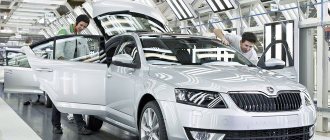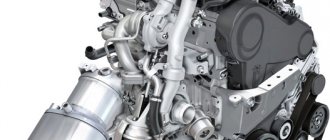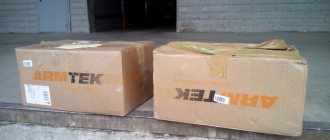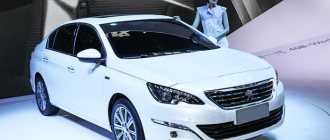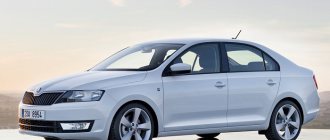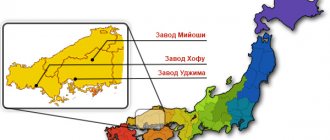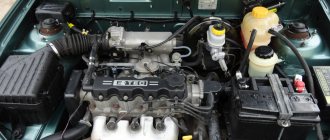A lot of cars are assembled in Russia, and recently there are more and more of them. Fans of some brands fundamentally refuse Russian-made cars. They say that ours will make everything worse and not as reliably as foreigners. Of course, it has always been believed that the performance of a car is affected by its assembly. This concept can be accepted, but it is better not to apply it to cars. After all, if a model is assembled in the country in which it will be sold, then it is better adapted for local roads. Who knows better the flaws of highways or potholes than Russian engineers?!
Today I would like to talk about the Volkswagen Jetta. This car is becoming more and more popular every year. Let's look at how it gained such trust, what appearance the model was given and where Volkswagen Jetta is assembled. In general, do our engineers produce the German Jetta model on a par with European ones or should we trust popular principles.
Countries where Volkswagen Jetta is assembled
The new version of the Volkswagen Jetta is being created in only two countries. Both modifications of the model are available to our consumers. They are collected in Russia and Mexico.
Mexican copies are being prepared for the European and American markets. Compared to our assembly, they are somewhat more expensive. But our consumers should not pay attention to such standards. After all, Russian roads and European highways are heaven and earth.
To the question of who assembles the Volkswagen Jetta for our market, the answer is very simple. It is made in Kaluga. We would like to say right away that only cars of this type are best adapted to our roads and the driving habits of Russian drivers.
Judging by the test drives, the Mexican assembly is not at all different from the Russian one. Both enterprises are equipped with the latest technology. All metal parts are imported from Germany, and in the car there are more than 70% of them.
Representatives of Volkswagen in the Russian Federation set a price for the basic configuration of the car at 648 thousand rubles. It is available with a 1.6-liter engine with a capacity of 105 horsepower.
Our engineers came up with the Conceptline package specifically for the Russian market. The transmission here can be of two options - a five-speed manual or a six-speed automatic. This fully corresponds to the European version of the car. Also, for Russia, the car is equipped with a full safety kit, power steering, infotainment system, air conditioning and electric drive.
A special winter package for the Volkswagen Jetta model has been invented for the Russian market. It includes heated mirrors, washer nozzles, a spare tire and wheels marked 6J*15 with decorative caps. The buyer can choose the color scheme of the car from eight options. The most popular of them are "Tornado" red, "Storm" blue and "Topaz" brown.
The second package of options that Russian engineers produce is the Comfort package. It includes all the above options, but with additional heated seats.
Also, the Technic version is available to our customers. It allows you to install towing protection and an anti-theft system with an additional immobilizer, CD/MP3 player and USB cables for iPod.
Cost of Russian versions of Volkswagen Jetta
Previously, the Trendline variant was used as a basic configuration. Due to Russian assembly, it has become cheaper and costs 688 thousand rubles.
The Conceptline modification will cost its customers from 733,000 rubles, and Highline is the most expensive. Russian engineers equipped it with a 1.4-liter diesel engine. It produces 122 horsepower, which is quite enough for our roads.
As you can see, our craftsmen did their best. They assemble a car no worse than the Mexicans. Therefore, when buying a model, do not worry about its durability and quality.
For this legendary sedan, produced by Volkswagen, which at all times enjoyed amazing steady demand and wild popularity, and now has its own niche. To assemble the Volkswagen Jetta, there are two factories, one of which is located in Mexico, and the second in Russia in Nizhny Novgorod.
The Mexican plant produces cars intended for the American and European markets, and the plant in Nizhny Novgorod works for the CIS market.
Plant in Nizhny Novgorod
This enterprise is one of the youngest in the structure of not only the Volkswagen concern, but also among. The start of full cycle production occurred at the end of 2012. The plant's production capacity is designed to produce up to 132 thousand cars, taking into account the fact that production has been mastered for three different Volkswagen and Skoda models.
The Jetta produced at the plant has undergone a certain adaptation to operation on Russian roads and in difficult climatic conditions. Ground clearance was increased to 160 mm, and the suspension was specially made harsh, taking into account not the smoothest roads. The suspension was further strengthened, in particular, more powerful shock absorbers and anti-roll bars were installed.
Among the few flaws that were discovered at the stage of purchasing a car, and during the first operating experience, the following can be distinguished:
- Use of defective rubber seals in rear door openings (delamination, uneven trim, mechanical damage). Easily fixed under warranty.
- With the exception of soundproofing of the engine compartment, all other areas should be further strengthened (wheel arches, doorways, luggage compartment).
- When operating in winter conditions, problems are noted in closing the trunk lock. Therefore, it is advisable to process it and prevent the accumulation of snow and moisture in the mechanism.
- Hard suspension and poor-quality roads transmit strong vibration to the parts of the front console, which leads to squeaks and rattling.
As unpleasant features of the car, the high cost of some options is noted, so it is better to install some car add-ons, navigation, multimedia system, parking sensors yourself.
Factory in Mexico
Mexican-made cars can be found both almost new and used. Please note that delivery of a new car is quite expensive.
The following shortcomings are noted on overseas Volkswagen Jettas:
- Poor quality of center console trim panels and door inserts.
- Insufficient noise insulation of wheel arches and doorways. Therefore, many people complete this gap on their own.
- The standard radio and speakers are of low quality, which not only does not provide the proper sound, but also leads to frequent breakdowns.
- Low quality paintwork, which is prone to minor damage (chips and scratches).
In every corner of the world, Volkswagen cars are recognized by their unique appearance and quality of parts. With such success, the company has been producing one of its famous models, the Jetta, for 40 years. This machine has gone through many changes, and a considerable number of transitions from generation to generation. Nowadays, official dealers of the brand offer this model with improved driving characteristics and a modernized design. Each generation of this car is also loved and appreciated by Russian buyers.
For many, the important fact is where the Volkswagen Jetta is assembled for the Russian market. In Russia, the official assembly and sale of this “German” model started in 2008. Here at the enterprise in Kaluga they opened a conveyor for the production of the fifth generation of the machine. The plant is equipped with the latest equipment, so cars are assembled here to all necessary standards. The Volkswagen Jetta model is produced with both diesel and gasoline power plants. Engine volume varies from 1.4 to 2.5 liters. Russian buyers were offered a choice of sedan with a five- and six-speed manual transmission, a six-speed automatic transmission, and a six- or seven-speed semi-automatic transmission. In EURO NCAP tests, this model received five stars for safety. I am also assembling the sixth generation of the Volkswagen Jetta at a Kaluga plant.
The main differences between the “Russian” VW Jetta
Until recently, to answer the question of where the Volkswagen Jetta is assembled, all one had to do was talk about the plant in Germany. However, times are changing, and today the version of the Jetta for the Russian market is assembled at two plants: in Kaluga and in Mexico. The Mexican assembly of the Volkswagen Jetta is intended for the European and US markets. As a rule, it is a little more expensive than the Kaluga assembly, but the “European” one is not adapted for our roads and “Russian driving”. Therefore, domestic car owners should not bother with the idea of purchasing a purely German-assembled Jetta.
If we compare the build quality of the Volkswagen Jetta, which is sold in Russia, it has a multi-link rear suspension, which is taken from the Volkswagen Golf. The American version of the car has a simplified version of the torsion beam suspension. If we talk about the Volkswagen Jetta model, which is intended for the European market, then two types of CAN buses are installed for data exchange between electronic components. There is only one in the American version, however, the quality of the models is very high.
In addition, the bodies of these versions are also designed to meet different passive safety requirements. The Russian version uses soft plastic, while the “European” version has a hard interior trim. Also, a domestic buyer can create a car assembly “on his own” by selecting optional equipment from the list. A “state” car enthusiast can only purchase fixed configurations.
It is also worth saying that in addition to the Volkswagen Jetta of Mexican, Kaluga, and German assembly, there is also a Chinese version. But, as practice shows, this is generally a kind of mix. It is only externally related to our and the European assembly, otherwise it is a completely different car, since in the Middle Kingdom, as in India, such cars are driven exclusively when accompanied by a personal driver. That is why Eastern consumers are offered such custom options as rear climate control, a control system for rear passengers, with which you can control the front passenger seat, audio system and navigation.
Stages of production of the “Russian” VW Jetta car
If we talk about the Kaluga assembly of the Volkswagen Jetta, then it and its quality are fundamentally no different from the Mexican one. The fact is that it carefully monitors the quality of cars produced at its factories, regardless of their geographical location. The plant in Kaluga is equipped with all the necessary technological innovations and innovative equipment.
The production line where the Volkswagen Jetta is produced has its own welding shop, in which the basic structure is created, then it is sent to the paint shop, where, according to a proprietary recipe, the structure is painted in the required color and then it is sent to the drying chamber. Next comes the actual assembly of the car, which consists of several stages:
- At the first stage of assembly, the interior is installed, where passenger seats, body doors, and interior trim are installed.
- At the next stage, the car is equipped with a power unit, transmission and the entire chassis. It is worth saying that all spare parts, load-bearing body elements and power plants are brought to the plant directly from Germany, so there is no need to worry about their quality, reliability and operational durability.
- Next, the already assembled Volkswagen Jetta is moved to the next production site - the so-called settling tank. The entire time the car is here, production inspectors inspect it for any defects or shortcomings. If they identify deficiencies, the production unit is immediately sent either to the appropriate workshop for modification or to scrap.
- A fully finished and fully equipped car, after passing thorough quality control and technical condition, is sent to dealerships for further sale.
Thus, today, regardless of where the Volkswagen Jetta is assembled, it remains an example of German quality and European perfection in everything. In other words, if domestic car owners choose this particular car model for themselves, then as a result they will certainly enjoy not only the comfort and ideally selected interior components, as well as optional equipment, but will also certainly appreciate the reliability and adaptive qualities of the VW Jetta.
The new seventh-generation Volkswagen Jetta will appear in Russia closer to the middle of next year, but Maxim Kadakov has already driven the new Jetta over 600 km on the roads and light off-road roads of Mexico - and here are his first impressions.
Where else is the model produced?
The Volkswagen Jeta sedan is considered the people's car. At least, this is how the manufacturer positions it for European and American buyers. For Russian consumers, this “German” is more a tribute to fashion. In addition to the Russian Federation, the new Volkswagen is assembled in one more country - Mexico.
The quality, safety and service life of the car depend on where the Volkswagen Jetta is produced. Mexico is the main market for this model. In addition, the Mexican version of the Jetta is supplied to the USA. Cars that are assembled in Mexico are more expensive than domestically assembled cars. If you look closely, the Russian assembly is almost no different from the “overseas” one. The Kaluga plant is equipped with the latest technology. In the welding shop of the enterprise, the initial design of the sedan is prepared, and in the paint shop the car is painted, after which it is sent to the drying chamber. Only after all these procedures does Jetta production begin.
Domestic build quality
Before proceeding to the reviews of the owners of the German sedan, I would like to note that the Conceptline package was created specifically for the Russian market. The car is offered with two types of transmission: five and six-speed gearbox. This version of the sedan will cost you 733,000 rubles. The Volkswagen Jetta is perhaps one of those cars about which there are no negative reviews. Now we are talking about a Russian-assembled Jetta. The owners are quite satisfied with the domestic car; they say that after using the vehicle, even the plastic does not begin to creak.
In the case of this model, it doesn’t matter where the Volkswagen Jetta is produced, because the quality is equally good. The Russian version of the sedan is not as susceptible to corrosion as other cars in this segment. The owners did not notice any defects in the welding of the body or in the gaps of the vehicle. But the Russian “German” still has one drawback - it’s low-slung. Therefore, we recommend that the Kaluga enterprise work on improving the car’s suspension so that it can be operated one hundred percent on Russian roads.
"was put into production in 1979 with an eye primarily on the American market. The front-wheel drive car had versions with two- and four-door bodies and was equipped with gasoline engines ranging from 1.1 to 1.8 liters (49–110 hp) and 1.6 liter diesel engines: naturally aspirated (53 hp) and turbocharged (69 hp). For an additional payment, buyers were offered a three-speed automatic transmission.
Russian-assembled Volkswagen Jetta
Recently, the popular Volkswagen Jetta cars began to be produced here in Nizhny Novgorod. What is this Russian German like? The car body is assembled and painted with high quality - you can’t complain. The adaptation is also pleasing - especially for Russian conditions, the ground clearance was increased to more than sufficient 16 centimeters.
The Volkswagen Jetta itself is distinguished by its impressive length, exceeding 4.6 meters. In its segment, this Volkswagen is one of the largest sedans.
By the way, buyers have no alternative to the four-door body; competitors in this regard are more diverse. The main rivals of the Russian-assembled Volkswagen Jetta are the Japanese Mazda 3 and Honda Civic, as well as the German Opel Astra.


